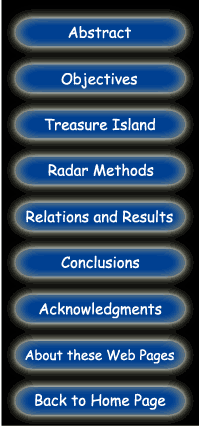
Crosshole GPR is a transillumination method in which two antennas are lowered down adjacent, parallel boreholes. The transmitter antenna emits a short pulse, or shot, of high frequency (100 MHz in this case) electromagnetic energy. The receiving antenna, located in the other borehole, precisely measures the time required for the signal to travel through the ground, along the plane separating the two boreholes. Careful calibrations are required to establish the travel time of the signal. In the field, 32 shots were collected at each antenna position. The multiple shots were "stacked" or added together to improve data quality and reduce noise.
Two different types of crosshole surveys were conducted: 1) a constant offset profile (COP), and 2) a multiple offset gather (MOG). The COP is a quick, reconnaissance type of survey in which both GPR antennas were lowered to equal depths down the boreholes for each shot. We used the COP to rapidly identify, in the field, anomalies in travel time and signal strength that would indicate variations in sediment properties. The COP data was also used to distinguish the hydraulic fill from Bay Mud and design a plan for more detailed radar surveys in the fill.
The MOG is a more detailed crosshole survey in which the transmitter antenna is fixed at a certain depth in one borehole while the receiver is moved in regular steps down the other. After the receiver collects shots from top to bottom (one complete MOG), the transmitter is lowered a predetermined step-interval and fixed at that new position, and the receiver is again moved down the other hole. The process is repeated until the transmitter reaches the bottom. In this study, we collected a suite of MOGs, each with a step-interval of 0.25 m. Unlike a COP, the path lengths in a MOG vary greatly from shot to shot. For each transmitter-receiver orientation, the path length is computed. In a perfectly homogeneous medium, the first arrivals would form a hyperbola. Deviations from a smooth hyperbolic pattern are indicative of variations in soil properties.



